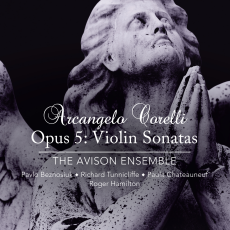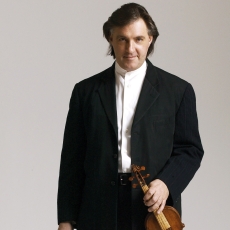The Avison Ensemble - Corelli: Opus 5 - musica Dei donum
Arcangelo Corelli is one of the best-known composers in history. The development of instrumental music, and especially the form of the trio sonata, in the late Baroque period is unthinkable without the influence of Corelli, through his sonatas and concerti grossi. The trio sonata would become one of the main forms of chamber music in the first half of the eighteenth century.
About the man himself surprisingly little is known. His career is well documented, although there are some white spots, especially in regard to his formative years, but there are conflicting testimonies of his character and the way he played. According to his pupil Geminiani it was 'nice ear, & most delicate taste, which led him to select the most pleasing harmonies & melodies, & to construct the parts so as to produce the most delightful effect upon the ear'. On the other hand, a contemporary described how Corelli 'suffered his passions to hurry him away...whilst he was playing on the violin' and added that his eyes turned 'red as fire' and his eyeballs rolled 'as in agony'. These observations seem to suggest that the music as it comes down to us in printed editions is only a shadow of what a performance in the composer's time must have been like.
This is supported by the many editions of Corelli's sonatas with added ornamentation which appeared soon after his death across Europe. Some of these editions were claimed to include ornamentation from Corelli's own pen. It was especially the set of twelve sonatas for violin and bc which was the subject of embellishment and arrangement. To the former category belong the editions of these sonatas in versions for recorder; several of these were produced and sometimes also published in England. Here Corelli's music was extremely popular and the recorder was still the main instrument among amateurs at the time it was rapidly becoming obsolete elsewhere. Among the latter category rank the concerti grossi which Geminiani based on the same Op. 5 set.
How far arrangers went in their treatment of Corelli's sonatas is demonstrated by Pavlo Beznosiuk. To the last movement from the Sonata in E major, Op. 5, No. 11 he adds four variations by Matthew Dubourg (1730-1767), an English violin virtuoso who was also a great promotor of Handel's oratorios. Probably in analogy to these variations Beznosiuk adds some of his own to the gavotta from the Sonata in F major, Op. 5, No. 10.
The second production is an example of the way Corelli's sonatas have been treated in the early eighteenth century. In the booklet we read: 'This recording brings together authentic masterpieces by Corelli in the original versions for recorder published by Walsh and by Pierre Mortier (Sonata No. 1 Op. 2) in the first years of the eighteenth century. For the Follia Op. 5/12 we chose Walsh's recorder version from 1702 together with the second violin part composed by Francesco Geminiani and also published by Walsh himself in London in its Concerti after Op. 5 of Arcangelo Corelli, thus creating a fascinating version for three: two recorders and basso continuo. We transcribed some Sonatas following the example of the original arrangements of the eighteenth century'.
Quite rare are the trio sonatas from Op. 2 and Op. 3. These performances with recorders are highly convincing, and this way the repertoire for recorder is greatly extended.
The performances are equally convincing. Lorenzo Cavasanti and Luisa Busca deliver outstanding performances. They produce a beautiful tone, play with great agility and pay much attention to the rhythmic pulse. The pronounced exposition of the latter is also due to the excellent support of the basso continuo group.


